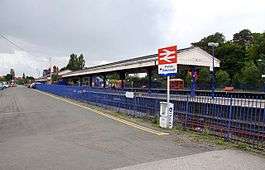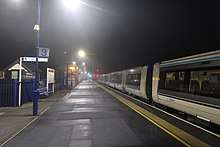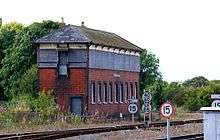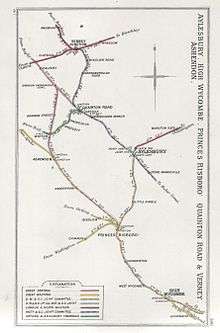Princes Risborough railway station
Princes Risborough station is a railway station on the Chiltern Main Line that serves the town of Princes Risborough in Buckinghamshire, England. It is operated by Chiltern Railways.
| Princes Risborough | |
|---|---|
 Princes Risborough Station. | |
| Location | |
| Place | Princes Risborough |
| Local authority | Buckinghamshire |
| Grid reference | SP799027 |
| Operations | |
| Station code | PRR |
| Managed by | Chiltern Railways |
| Number of platforms | 4 |
| DfT category | D |
| Live arrivals/departures, station information and onward connections from National Rail Enquiries | |
| Annual rail passenger usage* | |
| 2014/15 | |
| 2015/16 | |
| 2016/17 | |
| 2017/18 | |
| – Interchange | |
| 2018/19 | |
| – Interchange | |
| History | |
| Original company | Wycombe Railway |
| Pre-grouping | Great Western and Great Central Joint Railway |
| Post-grouping | GW & GC Joint |
| 1 August 1862 | Opened |
| 15 August 1872 | Services to Watlington begin |
| 2 April 1906 | Through services along GW&GCJR begin |
| 1957 | Services to Watlington withdrawn |
| 1963 | Services to Oxford withdrawn |
| August 2018 | Heritage Railway services to Chinnor began |
| National Rail – UK railway stations | |
| * Annual estimated passenger usage based on sales of tickets in stated financial year(s) which end or originate at Princes Risborough from Office of Rail and Road statistics. Methodology may vary year on year. | |
History
At one period there were four different railway routes from the northern end of Princes Risborough station, although there has only ever been one to the south.
The first railway to reach Princes Risborough was the Wycombe Railway, which opened its Oxford extension from High Wycombe as far as Thame on 1 August 1862.[1][2][3] There were three intermediate stations on this section: West Wycombe,[4] Princes Risborough and Bledlow. The cost of construction of the station building was £1104 9s 5d and additional general costs were £824 8s 0d. The station building as built was a typical Wycombe railway design with an open porch at the right hand end on the platform elevation, the design was the same as West Wycombe, Bledlow and Wheatley, and also on the original part of the Wycombe railway Cookham, Marlow Road, Wooburn Green and Loudwater. A branch of the Wycombe Railway was opened from Princes Risborough to Aylesbury on 1 October 1863.[3][5] The Wycombe Railway was worked by the Great Western Railway, and was absorbed by that railway in 1867.
The Watlington and Princes Risborough Railway opened its line on 15 August 1872; that railway became part of the GWR on 1 January 1884.[3][6]
The original station building was located a few hundred yards further north than the present site. The original building was extended at the north end to provide extra office accommodation between 1870 and 1880, and a curved roof canopy covering the platform may have also been added at the same time. Further additions to the building were made between 1894 and 1896.
A second platform was added when the Watlington branch was opened in 1872 although there was only a single track between the two platforms. In 1892 a new signal box was brought into use and a new passing loop, so the second platform was rebuilt with two tracks between them. A footbridge was also provided at this time.
The Great Western & Great Central Joint Committee was created with the dual objective of providing the Great Central Railway with a second route into London, bypassing the Metropolitan Railway; and of providing the GWR with a shorter route to the Midlands.[7][8] Central to this scheme was the upgrading of the existing GWR route between High Wycombe and Princes Risborough, which was transferred to the Joint Committee at its establishment on 1 August 1899. The line was extended in a north-westerly direction to Ashendon Junction, at which point the joint line ended, and a GCR route ran northwards to Grendon Underwood Junction, just south of Calvert; both sections opened for goods on 20 November 1905, and for passengers on 2 April 1906.[9][10] Continuing in the same north-westerly direction from Ashendon Junction, the Bicester cut-off line, which was purely GWR property, was opened for goods trains on 4 April 1910, and to passengers on 1 July 1910.[11][12]
The Watlington branch closed to passengers on 1 July 1957, and the route to Oxford via Thame closed on 7 January 1963;[3] services over the GCR route ceased on 5 September 1966,[10] leaving the present network of two lines to the north, to Banbury and to Aylesbury.
The station was transferred from the Western Region of British Rail to the London Midland Region on 24 March 1974.[13]
Chiltern Railways considered reinstating the Wycombe Railway's Oxford extension via Thame, but instead constructed a chord at Bicester to permit services to run from the main line onto the westernmost section of the Varsity Line, restored between Bicester and Oxford; this permitted a new service to Oxford which opened in 2015.

Part of the Watlington branch line has been reopened by the Chinnor and Princes Risborough Railway, which extended its heritage railway service to a new platform face at Princes Risborough station on the site of the former platform to Watlington, Platform 4; although the platform opened in August 2018, the platform as well as the Railway is still being maintained. Princes Risborough station currently has four platforms: Platform 1 for Aylesbury; Platform 2 from Aylesbury to London (via High Wycombe); Platform 3 for Bicester, Banbury, Oxford and Birmingham; and Platform 4 for the Chinnor and Princes Risborough Heritage Railway.
Originally, two through roads allowed non-stop running clear of the platform roads. Radical cuts on the Chiltern Main Line and Great Central Main Line in the 1960s left the station with only two usable platforms - the current platforms 1 and 2. In 1998 to increase capacity on the line Chiltern Railways reinstated platform 3, the down platform, on top of the old down platform road, in a manner similar to that at West Ruislip. Fragments of the original down platform are still visible at the station. The 'up' through road, removed from service as part of previous drastic running-down of the route which left only two usable platforms, was restored in September 2011 as part of Chiltern's Evergreen 3 upgrade project.
Signal box

Built in 1904, Princes Risborough North Signal Box, located towards the northern end of Platform 3, is the largest surviving Great Western Railway signal box in the country.[14] It closed in 1991 when modernisation of the line moved signalling operations to Marylebone and became a Grade II listed building after a successful public campaign to save it from demolition.
The Chinnor and Princes Risborough Railway Association were granted an agreement with National Rail allowing them to maintain the box and undertake restoration work after a period of neglect left the box damaged by weather and vandals.[15] Work had previously ceased in 1998 due to safety concerns but was resumed in 2013.[16]
Services and operators

The Monday to Friday off-peak service consists of:
- 2 trains per hour to London Marylebone
- 1 train per hour to Aylesbury
- 1 train per hour to Banbury (with some services continuing to Stratford-upon-Avon)
| Preceding station | Following station | |||
|---|---|---|---|---|
| Haddenham and Thame Parkway | Chiltern Railways Chiltern Main Line stopping services |
Saunderton | ||
| Haddenham and Thame Parkway | Chiltern Railways Chiltern Main Line fast services |
High Wycombe | ||
| Monks Risborough | Chiltern Railways Aylesbury - Princes Risborough |
Saunderton or Terminus | ||
| Disused railways | ||||
| Bledlow Line and station closed |
British Railways Wycombe Railway |
Saunderton Line and station open | ||
| Terminus | British Railways Watlington and Princes Risborough Railway |
Bledlow Bridge Halt Line and station closed | ||
| Ilmer Halt Line open, station closed |
Great Western Railway Bicester "cut-off" |
Terminus | ||
| Chinnor | Chinnor and Princes Risborough Railway | Terminus | ||
There are also peak time and evening services to Oxford and three direct trains a day to Birmingham Snow Hill.[17]
Facilities
The ticket office is manned for most of the day Monday to Friday and on Sundays. On Saturdays the ticket office is manned from the morning until early afternoon.[18]
There are two self-service ticket machines located just outside the station for use by passengers when the ticket office is closed or busy. There are also departure screens located on all three platforms and inside the waiting room.
The station has a waiting room, toilet facilities and step free access to all parts of the station: passengers reach platform 3 via lifts at either end of the footbridge. There is also a café.
Notes
- MacDermot vol. I, part I, p. 438
- Mitchell & Smith, Apr. 2002, Historical Background
- Mitchell & Smith, April 2003, Historical Background
- West Wycombe station under construction The Transport Archive
- MacDermot vol. II, p. 6
- MacDermot vol. II, p. 623
- MacDermot, p. 416
- Jenkins, pp. 8-9
- Jenkins, p. 11
- Mitchell & Smith, Nov 2006, Historical Background
- MacDermot, p. 448
- Mitchell & Smith, Sep 2002, Historical Background
- Railway Magazine, May 1974, p. 248
- "Largest surviving signal box re-opens in Princes Risborough". Bucks Free Press. 3 June 2014. Retrieved 11 September 2014.
- "Princes Risborough North Signal Box". Chinnor and Princes Risborough Railway. Retrieved 11 September 2014.
- "Princes Risborough North Signal Box: The Wilderness Years". Chinnor and Princes Risborough Railway. Archived from the original on 11 September 2014. Retrieved 11 September 2014.
- "Download our timetable | Chiltern Railways". www.chilternrailways.co.uk. Retrieved 11 December 2016.
- "Station Detail | Chiltern Railways". www.chilternrailways.co.uk. Retrieved 11 December 2016.
References
- Jenkins, Stanley C. (1978). The Great Western & Great Central Joint Railway. The Oakwood Library of Railway History. Blandford: Oakwood Press.
- MacDermot, E.T. (1927). History of the Great Western Railway. Vol. I (1st ed.). Paddington: Great Western Railway.
- MacDermot, E.T. (1931). History of the Great Western Railway. Vol. II (1st ed.). Paddington: Great Western Railway.
- Mitchell, Vic; Smith, Keith (April 2002). Paddington to Princes Risborough. Western Main Lines. Midhurst: Middleton Press. ISBN 1-901706-81-8.
- Mitchell, Vic; Smith, Keith (September 2002). Princes Risborough to Banbury. Western Main Lines. Midhurst: Middleton Press. ISBN 1-901706-85-0.
- Mitchell, Vic; Smith, Keith (April 2003). Branch Lines to Princes Risborough. Midhurst: Middleton Press. ISBN 1-904474-05-5.
- Mitchell, Vic; Smith, Keith (November 2006). Aylesbury to Rugby. Midland Main Lines. Midhurst: Middleton Press. ISBN 1-904474-91-8.
- Slater, J.N., ed. (May 1974). "Notes and News: Transfer of Marylebone-Banbury services". Railway Magazine. London: IPC Transport Press Ltd. 120 (877). ISSN 0033-8923.
External links
| Wikimedia Commons has media related to Princes Risborough railway station. |
- Train times and station information for Princes Risborough railway station from National Rail